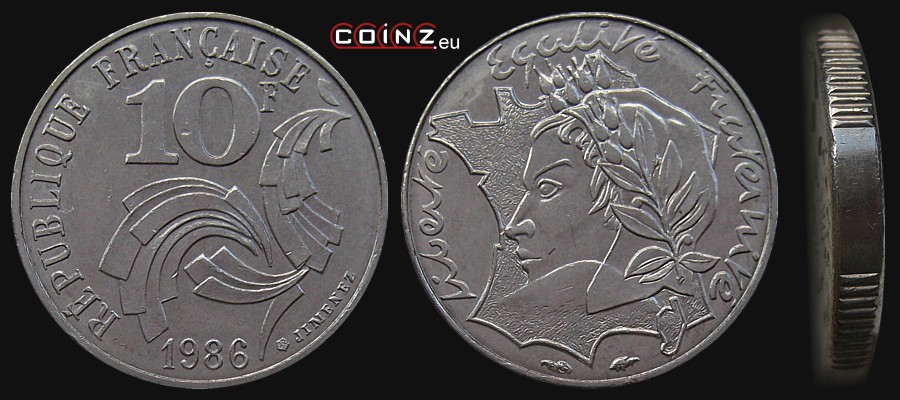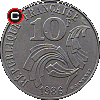10 francs FRANCE (1986)


| diameter: | weight: | thickness: | alloy: |
| 21.0 mm | 6.5 g | 2.5 mm | steel |
obverse:
in coin centre stylised rooster - symbol of France; above face value: 10 F (FRANCS); on the bottom year of issue 1986; along the top edge: RÉPUBLIQUE FRANÇAISE (French Republic)
reverse:
in the coin centre personification of France - Marianne's head in a laurel wreath facing left; in the background simplified map of France; along the top edge motto of France: LIBERTÉ ÉGALITÉ FRATERNITÉ (liberty, equality, fraternity)
edge:
five plain and five reeded sections
issue date:
26 V 1986
withdrawal date:
18 II 1987
designer:
Atelier de gravure (group of designers of the Paris Mint - rosette after year of issue 1986 in the obverse) based on design of Joaquin Jimenez (signature JIMENEZ after the rosette along the bottom edge of the obverse)
mint:
 La Monnaie de Paris (The Paris Mint), Pessac (mint mark at the bottom edge of the reverse on the left, on the right privy mark of mint's director Émile Rousseau - dolphin)
La Monnaie de Paris (The Paris Mint), Pessac (mint mark at the bottom edge of the reverse on the left, on the right privy mark of mint's director Émile Rousseau - dolphin)
mintage:
| 1986 | 87 927 011 | + 15 000 in annual boxed sets |
varieties:
There exists a stamp variety, in which the map of France, precisely Brittany, touches the frame of the reverse.
mint marks:
interesting facts:
This type of coins was supposed to replace the larger 10-franc coins, but it was quickly withdrawn from circulation, officially, due to too small size. Apparently the ordered diameter of 21 mm looked completely different in presentations of decision-makers than in reality. By the end of 1986, these coins were practically not functioning in circulation.
Rooster is a symbol of France (Gaul) since the Roman times. This symbol appeared probably during the Roman period based on a wordplay of Latin gallus, which meant both rooster and Celt from Gaul region.
Rooster is a symbol of France (Gaul) since the Roman times. This symbol appeared probably during the Roman period based on a wordplay of Latin gallus, which meant both rooster and Celt from Gaul region.
last update: 20 XI 2013
coins catalogue :: katalog monet :: münzkatalog :: catalogue de monnaies :: catálogo de monedas :: catalogo monete :: каталог монет :: κέρματα κατάλογος :: COINZ.eu
© 2010-2025 :: Adam Kubicki :: COINZ.eu :: All rights reserved.


